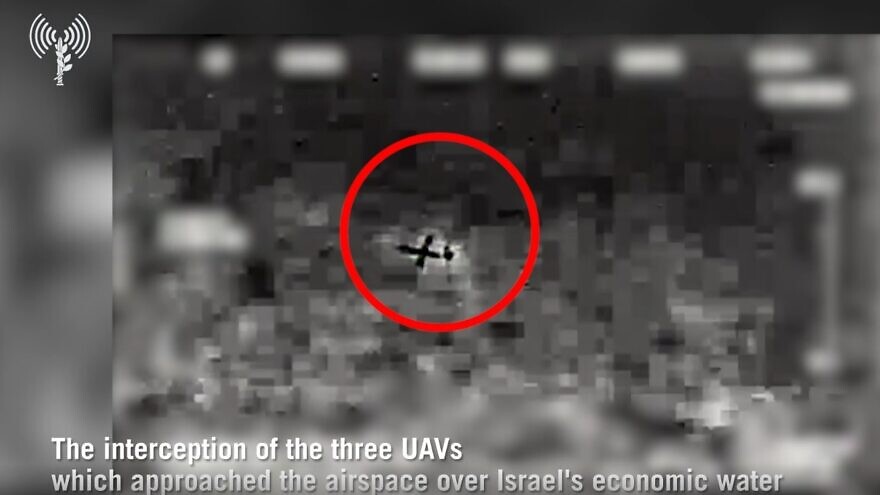
An Israeli Air Force F-16 and an Israeli Navy missile ship shot down the UAVs over the Mediterranean Sea on Saturday.
(July 2, 2022 / JNS) The Israel Defense Forces intercepted three unmanned aerial vehicles launched from Lebanon and flying in the direction of the Karish offshore natural gas platform, on Saturday.
An Israeli Air Force F-16 fighter jet from the 109th Squadron was scrambled from Ramat David airbase in northern Israel and shot down one of the UAVs. The other two UAVs were intercepted by Barak missiles fired from the Israeli Navy’s INS Eilat, Sa’ar 5-type missile ship.
According to the IDF, all three UAVs were intercepted over the Mediterranean Sea, several kilometers from the natural gas rig. The Karish offshore natural gas platform is a significant strategic economic and energy resource for Israel.

Israel considers any attack on its gas infrastructure as an act of severe aggression.
“The UAVs were identified by detection systems and monitored by ground control units throughout their flight. The UAVs were identified at an early stage and intercepted at the optimal operational point,” said the Israel Defense Forces in a statement.
The UAVs flew at low speed and at low altitude, in an attempt to bypass Israel’s advanced detection and interception systems.
According to the IDF, its detection and alert systems functioned as required, “embodying the concept of multi-layered air defense in the best possible manner in unison with the professional activities of the soldiers at sea and in the air who carried out the defensive mission with great success.”
“An initial inquiry suggests that the UAVs did not pose an imminent threat,” the military added.
The interceptions come as Israel and Lebanon have been engaged in indirect negotiations designed to settle a dispute over their maritime border. Economic waters belonging to both Israel and Lebanon are believed to contain large quantities of unexploited natural gas, in addition to the large discoveries made by Israel in recent decades. Talks between Israel and Lebanon have been mediated by the United States.
In June, Hezbollah threatened to attack Israel’s offshore gas-drilling activities in the Karish gas field, off the coast of Haifa, due to the unresolved maritime border.
On June 6, Hezbollah warned that it was ready to take military action against Israeli gas-production operations after the Greek-British company Energean sent a gas production ship to the area ahead of expected extraction work.
On June 9, Hezbollah chief Hassan Nasrallah called Israeli gas activities in the area “provocations.” He said that any Israeli drilling that takes place in advance of an agreement will be considered a direct assault on Lebanon. “All options are on the table,” he warned.

Maj. (res.) Tal Beeri, head of the research department at the Alma Center, told JNS that Hezbollah launched the UAVs “to send a message following the combative speech made by Hezbollah chief Hassan Nasrallah on June 9.” During that speech, Nasrallah said that solving the maritime border issue is as important as the “liberation” of southern Lebanon from Israel in 2000.
According to Beeri, launching the UAVs “is Hezbollah’s way of getting out of the corner that Nasrallah painted himself into during his speech. This is how to satisfy the Shi’ite ‘base,” adding that “Hezbollah works only according to its interest.”
On June 13, Reuters reported that Lebanon is preparing to offer a compromise deal to Israel via U.S. energy envoy Amos Hochstein to resolve the dispute. Hochstein landed in Beirut last month at the invitation of the Lebanese government.
Previous talks mediated by the U.S. failed to reach a resolution, after Lebanon “pushed its claim in the disputed zone from a boundary known as ‘Line 23’ further south to ‘Line 29,’ adding around 1,400 square km (540 square miles) to its claim, including part of Karish,” said the report.
Hochstein instead proposed a “field-swap that would create an S-shaped boundary instead of a straight line.” However, Lebanon has not agreed to the proposal according to reports.
It remains unclear whether Saturday’s incident will impact Israel’s willingness to conduct further negotiations with Lebanon at this stage.
To protect its offshore rigs from possible attacks, the IDF has equipped its navy with multiple defense systems.
Sa’ar 5-class Navy corvettes, the largest missile ships recently added to Israel’s arsenal, are equipped with the Israel Aerospace Industries-made Barak missile system and the Rafael-made C-Dome (naval Iron Dome) system.
The Israeli Navy recently completed a multi-layered combat exercise near one of its offshore gas platforms.
Hezbollah’s know-how on building and operating UAVs originates in Iran, which has also proliferated UAVs to its various terror proxies in Iraq, Syria, and Yemen. Iran’s Islamic Revolutionary Guards Corps has also launched UAVs directly at targets. In July, 2021, Iran launched UAVs at the commercial Mercer Street vessel traveling off the coast of Oman. The ship was managed by the London-based company Zodiac Maritime, which is owned by Israeli shipping magnate Eyal Ofer.
A UAV which struck the ship on July 30 killed two crew members on-board the vessel.
During Operation Guardian of the Walls in May 2021, Hamas attempted to strike Israel’s Tamar natural gas rig, off the southern Israeli coastline, with tens of rockets, but did not succeed.
In March 2021, IAF F-35 fighter jets intercepted two Iranian Shahed-197 UAVs, believed to be delivering weapons to the Hamas terrorist organization, while probing Israeli air defense capabilities.
Back in February 2018, an IAF Apache helicopter successfully intercepted an Iranian UAV that was launched from Syria and had infiltrated Israeli airspace.
Several Sunni Arab countries share Israel’s view of Iranian-made UAVs as a significant threat to their security. In recent years, Iranian-backed Houthi terrorists have fired UAVs at targets in Saudi Arabia and the United Arab Emirates.
In June, Israeli Defense Minister Benny Gantz said Jerusalem is building a U.S.-sponsored regional air defense alliance with Arab states, adding that the new cooperation has already led to the thwarting of attempted Iranian attacks.